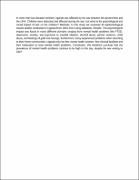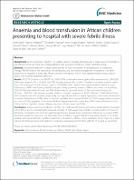Search
Now showing items 1-10 of 11
ICD-11 Trauma Questionnaires for PTSD and Complex PTSD: Validation among Civilians and Former Abducted Children in Northern Uganda
(Journal of Psychiatry, 2015)
Abstract
Objectives: ICD-11 is expected to introduce a new diagnosis of C-PTSD, along with a revision of the current
PTSD diagnosis. Are the suggested diagnostic tools for PTSD and C-PTSD valid in a developing country?
Method: ...
The Psychological Impact of War and Abduction on Children in Northern Uganda: A Review
(International Journal of Mental Health and Psychiatry, 2015)
In more than two decades northern Uganda was affected by the war between the government and the LRA. Children were abducted and affected during the war, but what is the psychological and social impact of war on the children? ...
Adult Learning: An Alternative Gateway to Women's Improved Participation in Children’s Education in Lango Region, Northern Uganda
(International Journal of Education, Training and Learning, 2022)
This research explored the contribution of Functional Adult Literacy training (FAL) and what it did to women’s involvement in children’s education in Apac District. The main objective of this study was to explore whether ...
Lactate clearance as a prognostic marker of mortality in severely ill febrile children in East Africa
(BMC Medicine, 2018)
Background: Hyperlactataemia (HL) is a biomarker of disease severity that predicts mortality in patients with sepsis
and malaria. Lactate clearance (LC) during resuscitation has been shown to be a prognostic factor of ...
Predicting mortality in sick African children: the FEAST Paediatric Emergency Triage (PET) Score
(BMC Medicine, 2015)
Background: Mortality in paediatric emergency care units in Africa often occurs within the first 24 h of admission
and remains high. Alongside effective triage systems, a practical clinical bedside risk score to identify ...
Exploring mechanisms of excess mortality with early fluid resuscitation: insights from the FEAST trial
(2013)
Background: Early rapid fluid resuscitation (boluses) in African children with severe febrile illnesses increases the
48-hour mortality by 3.3% compared with controls (no bolus). We explored the effect of boluses on 48-hour ...
Anaemia and blood transfusion in African children presenting to hospital with severe febrile illness
(BMC Medicine, 2015)
Background: Severe anaemia in children is a leading cause of hospital admission and a major cause of mortality in
sub-Saharan Africa, yet there are limited published data on blood transfusion in this vulnerable group.
Methods: ...
Pre‑hospital exposures to antibiotics among children presenting with fever in northern Uganda: a facility‑based cross‑sectional study
(BMC Pediatrics, 2022)
Abstract
Background: The rise in the indiscriminate use of antibiotics has become a major global public health problem and
presents the biggest global health challenge in the twenty-first century. In developing countries, ...
Treatment outcome among children underfive years hospitalized with severe acute malnutrition in St. Mary’s hospital Lacor, Northern Uganda
(BMC Nutrition, 2016)
Background: Severe malnutrition contributes to more than 60 % of deaths in children in developing countries. The
minimum international standard set for management of severe acute malnutrition is a cure rate of at least ...
WHO guidelines on fluid resuscitation in children : Authors’ reply to Southall
(BMJ Publishing Group Ltd, 2014)
Southall made several points about our recent article.1 2
He suggests that “lethal hyperchloraemia” secondary to use of
normal saline in FEAST (for boluses or maintenance) resulted
in excess mortality. However, he did ...










